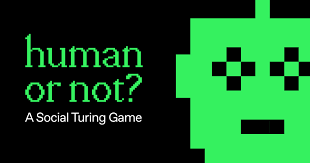
Introduction:
The Human or Not chat game has emerged as a groundbreaking “social Turing game,” inspired by Alan Turing’s renowned Turing Test. This online experience delves into the intriguing realm of artificial intelligence (AI) and challenges participants to discern between human and machine intelligence.
Evolution of the Game:
Originally developed by AI21 Labs as part of a time-limited research project, the first iteration gained massive popularity, prompting Humans & Ai Inc. to redevelop and relaunch the game. Now powered by cutting-edge Large Language Models (LLMs) like GPT-4, Claude, Cohere, and AI21 Labs’s Jurassic-2, the game showcases the latest advancements in natural language processing technology.
How to play Human or Not Chat Game :
Playing “Human or Not?” is a seamless process; with a single click on the dedicated website, players are randomly matched with either another player or an AI bot. The conversation initiator is also randomly assigned, and participants have a 20-second timer for each message. The game culminates in a two-minute dialogue, after which players must determine if their interaction was with a human or an AI, receiving instant feedback on the accuracy of their guess.
Popularity and Appeal:
The game’s popularity can be attributed to its alignment with the growing curiosity surrounding AI capabilities. With over 2 million participants in the primary version, the challenge of distinguishing between humans and AI fuels engaging debates. Results, showing nearly one-third guessing incorrectly, spark discussions on AI’s societal role and ethical implications. The social experiment aspect adds depth, making participation meaningful in contributing to a broader understanding of AI.
Outcomes of the Experiment:
Following the closure of the initial experiment, data from over 15 million conversations were analyzed. Findings revealed that 68% correctly identified interactions with AI, while 73% were successful in recognizing human interactions. Geographically, France excelled with a 71.3% accuracy rate, while India scored the lowest at 63.5%. Demographically, women and younger users outperformed their counterparts.
Reflection on AI’s Current State:
In essence, “Human or Not?” stands as a reflection of AI’s current state and its societal interaction. AI21 Labs, through this interactive platform, not only created a viral sensation but also contributed significantly to ongoing discussions on AI capabilities and ethical considerations. The game affirms Alan Turing’s predictions, signaling that we are at a juncture where AI convincingly mimics human conversation, challenging preconceptions and prompting reflections on AI’s future role.
The Bottom Line:
Whether for curiosity, debate, or scientific inquiry, “Human or Not?” has become a pivotal tool in understanding and navigating the complex world of AI and its societal implications. The new game, now accessible to everyone and created by Humans & Ai Inc., provides a unique opportunity for direct engagement with both AI and human interaction, fostering a better understanding and involvement with this evolving technology.